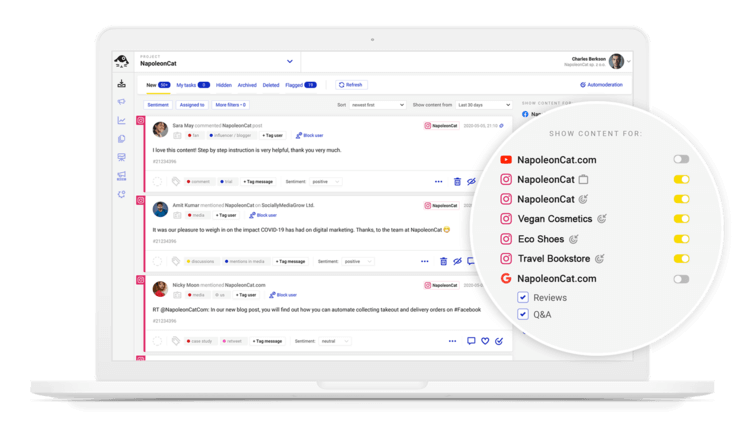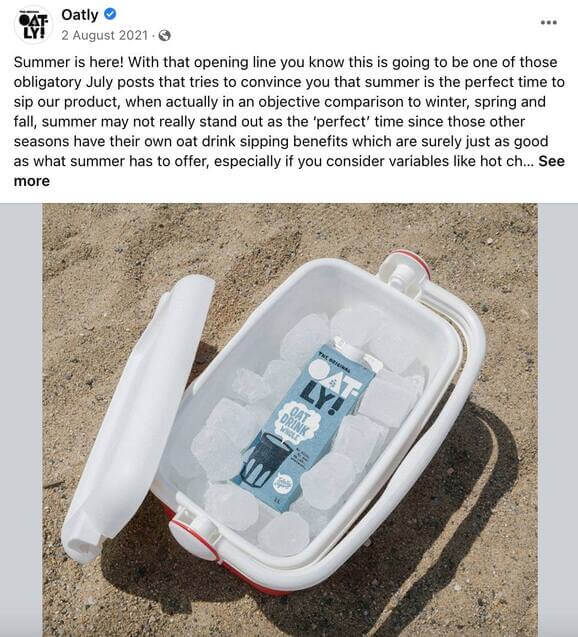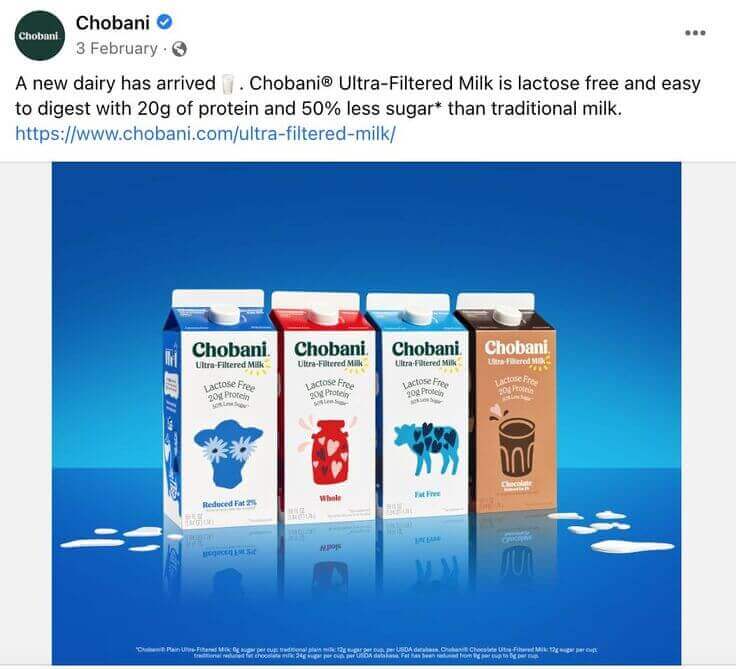Want to improve the effectiveness of your marketing communication, not just on social media? Start with finding your brand voice. Here’s a step-by-step method you can follow to define it.

Simplify Social Media
Management with One Tool
- Manage & reply to comments and DMs in one place.
- Monitor ad comments from multiple accounts.
- Automate answers to repetitive questions.
- Schedule posts to multiple accounts, on desktop.
- Analyze performance and monitor hashtags.
- Keep track of your competition.
- Create or schedule in-depth reports in seconds.
Wait, what’s a brand voice?
Yeah, I know you probably didn’t ask that one. But let me explain anyway.
Or, better yet, let me show you a couple of brand voice examples. Let’s take oat milk. Nothing exciting, right?
Take a look at two oat milk brands and how they communicate on social media channels.
Here’s one brand, Oatly:

And here’s another one, Chobani:

They both make oat drinks. Okay, they might have slightly different ingredients (although probably nothing revolutionary in either). They have different packaging and visual branding (which affects the visual side of their social media content, too.)
But what really sets them apart is how they communicate. Which – believe it or not – also has a huge impact when you’re actually picking a carton of oat milk from the store shelf.
(Especially if, like Oatly, you use your brand voice across all communication channels, including on your product packaging. Which is precisely why I picked Oatly the first time around, not knowing the brand at all yet. I just liked the copy on the package.)
And that difference is brand voice.
Oatly uses a particular kind of humor that’s easily recognizable in the brand’s social media content, on their billboards, and yes, on the very carton of their oat milk.
Chobani, on the other hand, is friendly but much more neutral (with a dash of emoji.) And, most likely, they’re attracting slightly different audiences, who are not just there for the taste of their oat-based products but also for the way these brands talk to them.
Because a brand voice is one of the primary ingredients that go into building an engaged audience of loyal brand followers. The kind that stick with you because they like you (and not just because you’re cheaper.)
And that’s no matter what your product or service is.
Why do you even need a brand voice?
I guess the above section should already explain that concept pretty well. But in case you need some more reasons, let me add some bullet points (an article needs bullet points, right?)
A distinct brand voice:
- Helps you stand out from other companies like you. I hate to break it to you, but (almost) anyone can create a similar product or service. But they can’t really copy your brand’s personality. And your voice can be your market differentiator, helping your brand personality shine through.
- Is an important part of a brand’s content strategy, helping you write and publish consistent content across all marketing communication channels. With a distinct brand voice, you always know how to write (and often also, what to write). If you create clear guidelines, you’re also making sure it’s consistent across authors and channels, helping build and maintain a recognizable brand image.
- Helps you reach the right target audience – of people who are right for you. The more defined that target audience is, the more compelling your communication can be. And apart from knowing who your audience is, you also learn who it isn’t (which is also important). Because no brand is “for everyone.” (We’ll talk more about it a little later on.)
- Might actually help you sell more (take Oatly’s example) by helping the ones your brand resonates with, they choose you instead of your competition when they’re making their purchasing decision. Yes, a brand voice can totally do that.
Without a defined brand voice, you’re just one of many brands in your niche, doing the same thing and selling similar products.

What’s the difference between brand voice and tone?
A brand voice is your overall way of speaking to your audience. It’s a set of guidelines you follow in general across marketing channels.
Now, just as we change tone when speaking in different situations, so can a brand. For example, if you’re generally upbeat and funny but speak to an upset customer on chat, you might assume a slightly more serious tone (jokes might be inappropriate when they’re complaining about a product or delivery. Your goal is probably to be more helpful and empathetic than funny.)
Slight changes in tone are normal, though I feel the more we communicate mostly online as brands, the more the tone becomes consistent.

Protect your social media from offensive comments and SPAM
Automatically hide or delete comments containing spam under your organic posts and ads – with an all-in-one social media tool.
How to define a voice for a brand – a step-by-step guide
Here’s a method you can use to arrive at your brand voice (and the corresponding tones).
Ready?
1. Start with your buyer profile
You likely have at least one ideal buyer, also known as a customer persona (and no, you can’t be selling to “everybody” – that’s just not a sustainable way to do business.)
Now, for your buyer profiles, it’s not enough to just determine the demographics (and many customer profiles stop there. That’s not really helpful.)
To build unique brand messaging, you need to know their so-called pains and gains – what bothers them, what problems they need solved, and what they want (from your product or service, but also from life in general.)
You also need to know how they consume content – this will fuel your content strategy, giving you a clear idea of what content to create for them and what channels to focus on. (And it’s not like “all women in their forties” have the same preferences and habits, you know.)
This is super important for spending your marketing budget effectively, might I add.
2. Describe your company culture
This combines who you are as a brand (your brand personality) and who you are as a company and team.
Are you more formal or relaxed? Do you use humor (and what kind?), or do you like to keep your communication as neutral as possible? What are your company values?
To make this a fun team exercise, you can use brand cards like these, for example. And there are also online tools that can help.
Or you can just have a brainstorm with your team and list some adjectives that describe you.
(By the way, here are some helpful social media branding tools if you’re looking.)
3. Then flesh out the adjectives that are important for your customers
It’s essential that your brand voice is authentic – as in, true to who you really are. But it also does have to resonate with your intended audience (the one that we’ve just defined in the buyer profiles.)
So pick six attributes that are most valuable to your customers. You’ll need them to define your brand communication style in a moment.
And an excellent way to do that is to ask your customers about what they think (also known as voice of customer research).
Some ways to collect voice of customer data and see how your audience communicates so that you can align your own brand voice with theirs are:
- Customer surveys
- Conversations on your brand’s social media platforms
- Review mining
- Looking at customer service emails or chat logs
- Call center software for direct insights
All of the above are great sources of input for creating your brand voice – and your overall brand messaging strategy.
4. List the qualities you want your brand voice to embody
Based on what you’ve done so far – defining what matters to your customers and who you are as a team – list three to four qualities that are the most important.
To make this easier, answer questions like:
How do you want to make your customers feel when they read your content and see your brand?
How do you want to be perceived by them?
What do you want to sound like?
And then focus on these.
5. Look at how your competitors communicate
To position yourself in your market niche and find a distinct brand voice (and your brand message), look at how your closest competitors communicate.
The goal is to find a way to stand out (no, not to copy anything they’re doing – that just doesn’t make sense.)
Do the same thing you did with your brand voice and find five adjectives that describe their communication style. How does yours stand out? And what can you do to sound unique and not like any of them?
6. Set the tone
Do you want to be formal, or not so much? A handy exercise is to define your brand’s tone on a scale – the one you’ll see in the template spans from The New York Times to Buzzfeed.
(Remember that there might be variations in tone depending on the channel/situation you’re using your brand voice in. So you might want to include those in the worksheet, too.)
Find samples of content that matches your desired brand tone of voice. What do you like about it? What are some characteristics you could adapt for your content?
Some of them might be, e.g.:
- The use of emoji or slang,
- Avoiding passive voice to avoid sounding formal,
- And other stylistic choices that can help you articulate your brand’s personality and voice.

7. Create a brand voice chart for all your content creators
To make sure you really come across the way you want to and do it consistently in all your content and on all channels, anyone writing any content for you should have your clear brand voice guidelines in front of them.
And actually, not just your writers or social media moderators, but also your social media customer service team or your sales team. Anyone communicating anything directly to customers should be on the same page.
Focus on the dos and don’ts when writing content and include all the things that your content creators should keep in mind, like:
- What kind of humor is allowed
- How to talk about your brand (and how NOT to do it)
- When it’s ok to use emojis (if at all)
- Etc.
What definitely helps is having an editorial calendar that gives you and your team members a look at all the content that’s in the pipeline and helps design content for social media and other channels more effectively.
8. Make your brand voice an integral part of your editorial guidelines
It’s one thing to define the length of your articles, but another to make sure however many words you use are written in your brand’s unique voice. So include your brand voice guidelines in the general editorial guidelines you hand out to your authors.
This will be the “what it should sound like” part that should go into writing any piece of content, whether it’s a social media post, a blog article, or new copy for your website or customer emails.
I can’t stress it enough – everyone should use it. And every team member and every department should have access to it, including your freelance creators and influencers you work with.
Make creating consistent content a habit for everyone
Completing the brand voice worksheet is just the first step. Then there’s the whole story with executing it across your teams.
When you think of social media content specifically, using social media tools for small and growing business like NapoleonCat will go a long way in helping implement your brand voice across conversations with customers.
Especially when you have more people on your team and need to coordinate your efforts to provide better social media customer service – and build a more consistent brand.
Which is what I hope this article will make slightly more manageable. 🙂

Simplify Social Media
Management with One Tool
- Manage & reply to comments and DMs in one place.
- Monitor ad comments from multiple accounts.
- Automate answers to repetitive questions.
- Schedule posts to multiple accounts, on desktop.
- Analyze performance and monitor hashtags.
- Keep track of your competition.
- Create or schedule in-depth reports in seconds.


